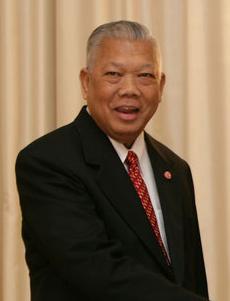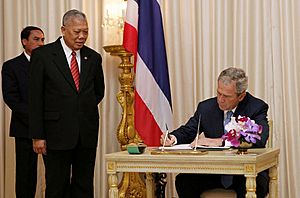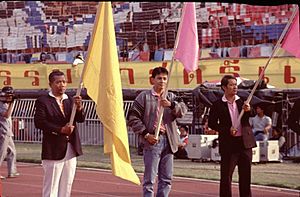Samak Sundaravej facts for kids
Quick facts for kids
Samak Sundaravej
MPCh MWM PPh TCW
|
|
|---|---|
| สมัคร สุนทรเวช | |

Samak Sundaravej in 2008
|
|
| 25th Prime Minister of Thailand | |
| In office 29 January 2008 – 9 September 2008 |
|
| Monarch | Bhumibol Adulyadej |
| Preceded by | Surayud Chulanont |
| Succeeded by | Somchai Wongsawat |
| Minister of Defence | |
| In office 6 February 2008 – 9 September 2008 |
|
| Prime Minister | himself |
| Preceded by | Boonrod Somthat |
| Succeeded by | Somchai Wongsawat |
| 13th Governor of Bangkok | |
| In office 23 July 2000 – 28 August 2004 |
|
| Preceded by | Bhichit Rattakul |
| Succeeded by | Apirak Kosayodhin |
| Minister of Interior | |
| In office 8 October 1976 – 19 October 1977 |
|
| Prime Minister | Thanin Kraivichien |
| Preceded by | Seni Pramoj |
| Succeeded by | Kriangsak Chamanan |
| Personal details | |
| Born | 13 June 1935 Bangkok, Siam |
| Died | 24 November 2009 (aged 74) Bangkok, Thailand |
| Political party | People's Power (2007–2008) |
| Other political affiliations |
|
| Height | 1.79 m (5 ft 10 in) |
| Spouse | Surat Sundaravej |
| Alma mater |
|
| Signature | |
| Military service | |
| Allegiance | Thailand |
| Branch/service | Volunteer Defense Corps |
| Rank | VDC Gen. (Honour rank) |
Samak Sundaravej (Thai: สมัคร สุนทรเวช, RTGS: Samak Sunthorawet; 13 June 1935 – 24 November 2009) was an important politician in Thailand. He served as the Prime Minister and Minister of Defense in 2008. He was also the leader of the People's Power Party during that time.
Contents
Early Life and Interests
Samak was born in Bangkok, Thailand. His parents were Phraya Bamrungratchaboriphan and Khunying Amphan Bamrungratchaboriphan. He had five brothers and sisters. His family came to Thailand from China in the late 1700s.
Samak went to Saint Gabriel's College and Assumption Commercial College. He later studied law at Faculty of Law, Thammasat University. He also got diplomas from Chulalongkorn University and Bryant & Stratton College.
Besides politics, Samak was famous for his cooking show. For seven years, he hosted a show called Tasting, Ranting on TV and radio. When he became Prime Minister, he wanted to continue his cooking show. However, a court later ruled that it was not allowed for a government minister to have another paying job. This decision led to him leaving his position as Prime Minister.
Samak was married to Khunying Surat Sundaravej. She worked as a financial adviser. They had two children together.
Political Journey
Samak started his political career in 1968. He joined the Democrat Party. He had strong connections with the military. In 1976, he became the Deputy Interior Minister. He was known for taking action against activists.
After a major political event in October 1976, Samak became the Minister of the Interior. He then started a campaign that led to many arrests.
In 1979, Samak started his own political group called the Thai Citizens' Party. This party became very successful in Bangkok elections.
In 1992, Samak was the Deputy Prime Minister. During this time, there were large protests for democracy. Samak supported the military's actions to control the protests. He believed the government had the right to restore order.
From 2001 to 2006, the Thai Rak Thai party was in power. This party was led by Prime Minister Thaksin Shinawatra. In 2006, the military took control of the government. The Thai Rak Thai party was later dissolved. Many members of this party then formed a new group called the People's Power Party.
In 2007, the People's Power Party won the election. Samak, as the party's leader, became the Prime Minister of Thailand. Some people believed he was working for Thaksin Shinawatra, who was living outside Thailand. This led to large protests.
No-Confidence Vote
In June 2008, the Democrat Party tried to remove Samak and his government. They filed a "no-confidence motion." This is a vote to see if the parliament still trusts the government. After a long debate, Samak and his ministers survived the vote. This meant they kept their positions.
Government Challenges
Samak's government faced many problems in July 2008. Several high-ranking officials resigned or were removed from their posts. One minister, Noppadon Pattama, was removed because his agreement with Cambodia about the Preah Vihear temple did not get parliamentary approval. This was a violation of the constitution.
Political Crisis of 2008
Many groups demanded that Samak resign. But he said he would not. He also met with King Bhumibol Adulyadej to discuss the situation.

Later, about 30,000 protesters took over the Government House in Bangkok. This forced Samak and his team to work from a military building. Protesters also blocked airports in Phuket, Krabi, and Hat Yai. This caused many flights and trains to be cancelled. Police issued arrest warrants for protest leaders. The army chief said the army would not take over the government.
On September 2, 2008, after clashes between protesters, Samak declared a state of emergency. This was lifted on September 14, 2008.
Court Decision and End of Premiership
On September 9, 2008, the Constitutional Court of Thailand made an important decision. The court ruled that Samak could not be Prime Minister anymore. This was because he had continued to work for a private TV company while in office, which was against the constitution.
Even after this ruling, Samak's party wanted to vote him back into power. Samak said he would accept the nomination. However, some other parties in the government coalition did not agree.
Stepping Down
Samak eventually decided not to try to become Prime Minister again. He also stepped down as the leader of the People's Power Party.
Somchai Wongsawat, who was the brother-in-law of former Prime Minister Thaksin Shinawatra, then became the new Prime Minister on September 17.
Political Roles
- Member of Democrat Party (1968–1976)
- Member of Parliament (1973–1975, 1976, 1979–1983, 1986–1990, 1992–2000, 2008)
- Founder and Leader of Prachakorn Thai Party (Thai Citizens' Party) (1979–2000)
- Deputy Minister of Agriculture and Cooperatives (1975)
- Deputy Minister of Interior (1976)
- Minister of Interior (1976–1977)
- Minister of Transport (1983–1986, 1990–1991)
- Governor of Bangkok (2000–2004)
- Senator-elected (2006; later cancelled by a military takeover)
- Leader of People's Power Party (2007–2008)
- Prime Minister (2008)
Leading the People's Power Party
In 2007, many former members of the Thai Rak Thai Party decided to join the People's Power Party. This happened after the Thai Rak Thai Party was dissolved by a court. Samak Sundaravej was elected as the leader of this new party. It was widely known that Thaksin Shinawatra supported Samak for this role.
In the general election on December 23, 2007, the People's Power Party won the most seats. They formed a government with a group of six other parties.
On January 28, 2008, Samak was elected Prime Minister by the parliament. He was officially approved by the King the next day. On February 6, his cabinet, including himself as Minister of Defense, was sworn in.
Samak ended his effort to regain his position as Prime Minister on September 12, 2008. His close aide announced that Samak would step down as party leader and would not accept the prime ministership. This decision helped to calm the political situation in Thailand.
Later Life and Death
In October 2008, Samak shared that he had liver cancer. He had surgery and treatment. On November 24, 2009, Samak passed away at the age of 74 due to liver cancer.
His funeral was held at Wat Benchamabophit. Crown Prince Maha Vajiralongkorn attended the ceremonies. Samak's ashes were later scattered in Sattahip Bay.
Images for kids
See also
 In Spanish: Samak Sundaravej para niños
In Spanish: Samak Sundaravej para niños
- Samak Interview on Al Jazeera
- Cabinet of Thailand






